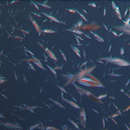Comprehensive Description
provided by Smithsonian Contributions to Zoology
Watasenia scintillans (Berry, 1911)
ORIGINAL REFERENCE.—Abraliopsis scintillans Berry, 1911:93.
DEPOSITION OF TYPES.—Holotype: CASIZ 21667 (previously 453), female, 59 mm ML, Japan (label lost, exact locality and date unknown), SSB no. 147.
Paratypes: USNM 816498, 2 females, 52 mm ML, 55 mm ML, same lot as holotype, dried and in very poor condition.
GEOGRAPHICAL DISTRIBUTION.—Off Japan (Okutani, 1967; Okutani et al., 1987; Tsuchiya, 1993).
COMMENTS.—Considerable confusion exists concerning the type locality of this species. In the original description, Berry (1911:94) gave measurements and locality (Japan) for only one specimen. In a subsequent paper, Berry (1912:425, figs 3, 4, pls. 7–9: figs. 1–6) expanded the species description, elaborated on the locality (Japan, probably off Misaki (Alan Owston?)), and gave his catalog number (SSB 147, cotypes, 3 females) for the type lot. In addition, he listed three other females examined (taken at Misaki by Ishikawa, SSB 279). The following year Berry (1913c:591) attempted to correct his locality information and wrote that “I had supposed my specimens to have been taken at Misaki, Sagami, but Drs. Ijima and Ishikawa have written me that this locality is probably erroneous. Ishikawa states that my specimens No. 279 really came from Uwotu on the Japan Sea, Watase quotes Toyama as a locality, and I have recently received specimens from Namerigawa, Ecchiu.” The correction of the locality of SSB 279, however, does not change the type locality, as SSB 279 is not part of the type series. Berry's entry for SSB 147, on 18 February 1911, in his specimen card-catalog states that (1) the specimens were found in the L.S.J.U. collections without any label and (2) Dr. Heath thinks them R/V Albatross material and most probably from Monterey Bay, California. Therefore, the type locality must simply be Japan with the more exact locality unknown.
Abralia japonica Ishikawa, 1929, is a synonym (Tsuchiya and Okutani, 1988). Data of Sasaki (1914) indicate that this is a mesopelagic-boundary species.
PYROTEUTHIDAE Pfeffer, 1912
TYPE GENUS.—Pyroteuthis Hoyle, 1904.
DIAGNOSIS.—Buccal crown with 7 or 8 supports. Buccal connectives attached to dorsal margins of arms IV. Secondary buccal connectives attached to ventral margins of arms I and II. Gladius with small, strongly pointed conus and elongate cone field; rostrum absent. Hooks present on (at least) arms I–III; presence on tentacular club varies with genus; armature on manus always in 4 series. Photophores present on viscera, eyeballs, and tentacles. Photophores absent from fins, mantle, funnel, head, and arms. Nidamental glands present; oviducal glands normal on one side, may be reduced or absent on other side. Oviduct single or unpaired. Fins subterminal; posterior lobes present. Tail not fleshy; vesicles absent. Nuchal folds absent. Tentacles with permanent constriction and bend near base; stalk “ligament” and vein leave tentacle distal to base and not in membrane. Ink sac embedded in digestive gland.
Pyroteuthis Hoyle, 1904
TYPE SPECIES.—Enoploteuthis marqaritifera Rüppell, 1844, by indication.
DIAGNOSIS.—More than 13 hooks per arm; hooks in 2 series; hooks present on arms IV. Tentacular club with 1 series of hooks on manus, 3 series of suckers on manus. Eyeball photophore number 6 (= lidded photophore) absent (numbering based on Pterygioteuthis eye, Chun 1910, pl. XIV: fig. 6). Six or 7 separated photophores in tentacular stalk. Oviducts unpaired (right oviducal gland may be reduced in size depending on species). Right arm IV hectocotylized; toothed plate absent.
- bibliographic citation
- Voss, N. A. and Sweeney, M. J. 1998. "Systematics and Biogeography of cephalopods. Volume I." Smithsonian Contributions to Zoology. 1-276. https://doi.org/10.5479/si.00810282.586

